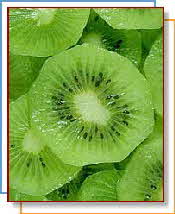See also: Kiwi Fruit Kitchen Tips
KIWI FRUIT
What's in a name? Kiwifruit (Actinidia chinensis) were called Yangtao in China, their country of origin, renamed Chinese gooseberry when they were introduced to New Zealand in 1906, and finally named kiwi fruit when imported into the U.S. market in the early 1960s. The French call it souris végétales, 'vegetable mice'.
There are more than 400 different varieties of kiwi fruit in China where they have been used for over 700 years.
 Kiwifruit can be medium or small in size, although most are small. They are brown and fuzzy on the outside and bright green on the inside with tiny black seeds. The shell or skin of the fruit can be eaten or peeled.
Kiwifruit can be medium or small in size, although most are small. They are brown and fuzzy on the outside and bright green on the inside with tiny black seeds. The shell or skin of the fruit can be eaten or peeled.
Kiwifruit is a member of the botanical family Actinidia and there are 400 different varieties. Kiwifruit vines are trained to grow on a trellis, and vines can be as high as 15 feet. This helps plants get enough light and air for optimal fruit quality. The fruit hangs down along the sides, like table grapes. The Hayward variety is the most popular U.S. variety.
The flavor is a mixture of peaches, strawberries, and melon with a soft and juicy texture. It's one of the most popular fruits today. Kiwifruit is high in antioxidant vitamin C and a good source of fiber, vitamin E and potassium. It is fat free, sodium free and cholesterol free.
Did you know kiwifruit could also be used as a natural meat tenderizer? That's because kiwifruit contains an enzyme called Actinidin. Just cut in half and rub kiwifruit over the meat, or peel and mash with a fork then spread it on the surface of the meat and let stand for 10 to 15 minutes or longer. The enzyme Actinidin also breaks down protein in dairy products. That's why when kiwifruit is combined with low fat ice cream, yogurt, or sour cream, it's best to serve and eat it right away.
Also see: Food Articles and Cooking Tips
You are here > Home >
Please feel free to link to any pages of FoodReference.com from your website.
For permission to use any of this content please E-mail: james@foodreference.com
All contents are copyright © 1990 - 2025 James T. Ehler and www.FoodReference.com unless otherwise noted.
All rights reserved. You may copy and use portions of this website for non-commercial, personal use only.
Any other use of these materials without prior written authorization is not very nice and violates the copyright.
Please take the time to request permission.
FOOD TRIVIA and FOOD FACTS
Popular Pages
CULINARY SCHOOLS
& COOKING CLASSES
From Amateur & Basic Cooking Classes to Professional Chef Training & Degrees
Home | Articles | FOOD TRIVIA | Today in Food History | Food_Timeline | Recipes | Cooking_Tips | Food Quotes | Who’s Who | Culinary Schools and Tours | Food_Trivia_Quizzes | Food Poems | Free Magazines | Food Festivals & Events
FoodReference.com (since 1999)
FOOD TRIVIA and FOOD FACTS SECTION
